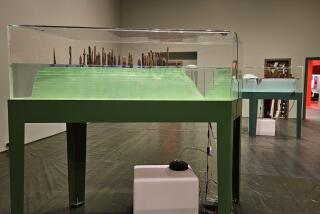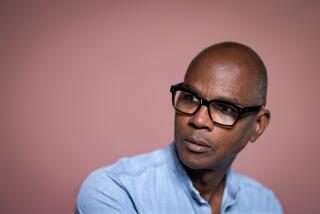Mike Kelley’s art students remember their mentor with fondness
- Share via
In 1992, the acerbic polymath Mike Kelley took a teaching position at Pasadena’s Art Center College of Design. With his midcareer retrospective, “Catholic Tastes,” set to show at the Whitney the next year, Kelley was a freshly minted art star, embarking on a decade that would see him accomplish some of his most high-profile work, including collaborations with Paul McCarthy, his brethren in the grotesque, and the Educational Complex (1995), a haunting fusion of every school he attended, as well as his childhood home, chillingly rendered as an architectural model.
Working as a teacher was the kind of contrarian move Kelley, a native of Detroit, often favored throughout his career. In Kelley’s hands, teaching seemed like working man’s performance art, positioned to buck the art world’s bourgeois pretension that to teach, even at the university level, was a sign that an artist hadn’t hacked it in the market. But here was Kelley, speaking to packed audiences in European art capitals like Vienna but coming back to Pasadena to turn on young students to avant-garde artists such as filmmaker Pat O’Neill.
Of course, Kelley’s academic career was more than a stunt designed to chafe the art world — that was only a convenient byproduct. It seems that Kelley, who died of an apparent suicide in January, derived a great deal of sustenance, intellectual and community-based, from his years as a teacher. For certain, his students drew a reservoir of support — sometimes in the form of fiery, searingly honest critique — from Kelley, who taught at Art Center until 2007.
MIKE KELLEY: Career in pictures
The following recollections are taken from interviews with Kelley’s former students, who painted a picture of a teacher who was generous, patient, sometimes harsh but above all, eager to engage and share with fellow creators.
A student portrait of Mike Kelley
“Mike was a major draw for me to go to Art Center. I got accepted to UCLA, and UCLA is a lot cheaper. but I really wanted to work with Mike. I think he was a major draw for a lot of people.” — Jason Yates, Art Center MFA graduate, 2000
“In 1998, when I was applying to grad school, I bought [Kelley’s catalog for his Whitney retrospective], ‘Catholic Tastes.’ There was a quote at the start of the book: ‘If I have been able, without scandalizing anybody, to enter cesspools, to handle putrid substances… why should I blush to open a cesspool of another kind (a cesspool filthier, I assure you, than all the rest), in the reasonable hope of doing some good by examining it in all its aspects?’ I read that and knew I wanted to study with him. It was the respect for the seriousness of the nastier parts of existence that struck me as completely vital. It was enough to make me move to L.A.” — Julian Hoeber, Art Center MFA graduate, 2001
“He was scraggly, very young. He looked like Gary Oldman from ‘Prick Up Your Ears’ and Pee-wee Herman together. He had that John Doe kind of punk-rock look. He was about listening, rather than telling. We had some teachers who would just tell you how to make art — that wasn’t Mike’s approach.” — Ophelia Chong, Art Center BFA graduate, 1989
“He was very direct and extremely funny. He took everything very seriously, but he had a great sense of humor and this magnetic laugh.” — Jennifer West, Art Center MFA graduate, 2004
“Mike was on my thesis committee, which consisted of him, Tim Martin, Stephen Prina, Patti Podesta and Benjamin Weissman. The committee meetings were such interesting discussions because they were all friends and had a great rapport. Mike had a very theoretical mind, but he wasn’t lofty about it. He had an ability to take everyday culture and analyze the ideological implications of it.” — Sharon Lockhart, Art Center MFA graduate, 1993
“Mike made clear that all forms of cultural production — whether it was pop songs or ads or abstract paintings — could be understood semiotically. All things, especially those that seem the most obvious and flat, demand analysis.” — J.H.
“In the late ‘80s, people were starting to get interested in serial killers — those morbid, serial killer books, and those John Wayne Gacy paintings. It was creepy and funny, totally ridiculous. Mike was the kind of person who drew me into that world; he saw the humor in it.” — O.C.
“One thing Mike railed against was one-trick ponies. He encouraged you to dig deep and not get too comfortable.” — J.Y.
“In my first review panel, while everyone else was trying to find something nice to say, Mike cut to the chase. He just shrugged his shoulders and said in his nasal tenor, ‘That’s it? That’s all you did? In two terms?’ I’m pretty sure I cried after they left the room. But I got the message, and I worked harder than I ever had after that.” — J.H.
“Mike didn’t put up with anything trite. He didn’t like cute.” — O.C.
“I put this DVD of my work in his mail slot and later on he told me, ‘I just hated that piece, everything about it.’ — J.W.
“Mike never wanted to be obscure, I think. He never lorded his knowledge over me. He was very generous in the way that he wanted other people to know the stuff he knew — even the crap. I remember him coming into my studio one day and he had a copy of a film by a very famous artist. He handed it to me and said, ‘You should watch this. It’ll show you exactly what you shouldn’t do.’” — J.H.
“After graduating, I worked as one of his assistants, and the dialogue on art and ideas continued. We would go out for these Friday lunches at some place like the Sizzler salad bar. That was classic Mike. He’d drive us there with the pacifier hanging from the mirror in his old Volvo. We’d talk about film and music. Mike was great at noticing when there was an onslaught of a certain kind of movie being made; we were both fascinated with vampire culture — ‘True Blood’ and ‘Twilight.’” — J.W.
“I learned from Mike to never be ashamed of what you like and are influenced by even if they were totally unfashionable. Because he never was.” — J.H.
“Mike was the one instructor who would show up at your exhibitions whereas most wouldn’t. There wasn’t much of a separation between him as an instructor and an artist.” — J.Y.
“He took teaching and art-making incredibly seriously. He wasn’t doing it as a job but as a way of approaching life in a creative way.” — S.L.
“He could get into moods sometimes. You’re at art school and there are moods everywhere, so it wasn’t anything unusual. But he would get very quiet and you had to pull things out of him. I didn’t ever pry about his life; he wasn’t the kind of person to talk about himself.” — O.C.
“As an individual, Mike was not intimidating. Mostly he was very warm, but his practice was intimidating. It could be difficult, as a developing artist, to be exposed to someone so resolved and committed. There was this insecurity in the back of your mind that you’re never going to be as smart as Mike. I mean, the guy couldn’t take a shower without reading a book.” — J.Y.
“I felt he really cared about his students. In my own work as a teacher [at USC’s Roski School of Fine Arts] I would like to think I bring something similar to their lives. I take them seriously as artists and try to bring both humor and criticality into their lives.” — S.L.
“At the end of the day, Mike knew that the fluff of the art world meant nothing; he was devoted to a very genuine and generous kind of artistic expression that was about building community and interaction. He recorded my daughter’s band, Dolphin Explosion, that she had with [Kelley’s close friends] Jim Shaw and Marnie Weber’s daughter. They were 8 or 9 at the time. I remember him saying, ‘You know I’m doing this because it’s going to be important later.’ He recorded them in his studio and released it on his label. He wanted it represented well. — J.W.
“Art Center wanted to kick me out and if not for Mike, I wouldn’t have graduated. He campaigned for me to stay there and gave me a job as an assistant. That’s how involved he was. At a time when I had all sorts of problems and was otherwise unemployable, he gave me a sense of pride and self-worth. He had a special place in his heart for the losers. I will be forever grateful to him.” — J.Y.
More to Read
The biggest entertainment stories
Get our big stories about Hollywood, film, television, music, arts, culture and more right in your inbox as soon as they publish.
You may occasionally receive promotional content from the Los Angeles Times.










